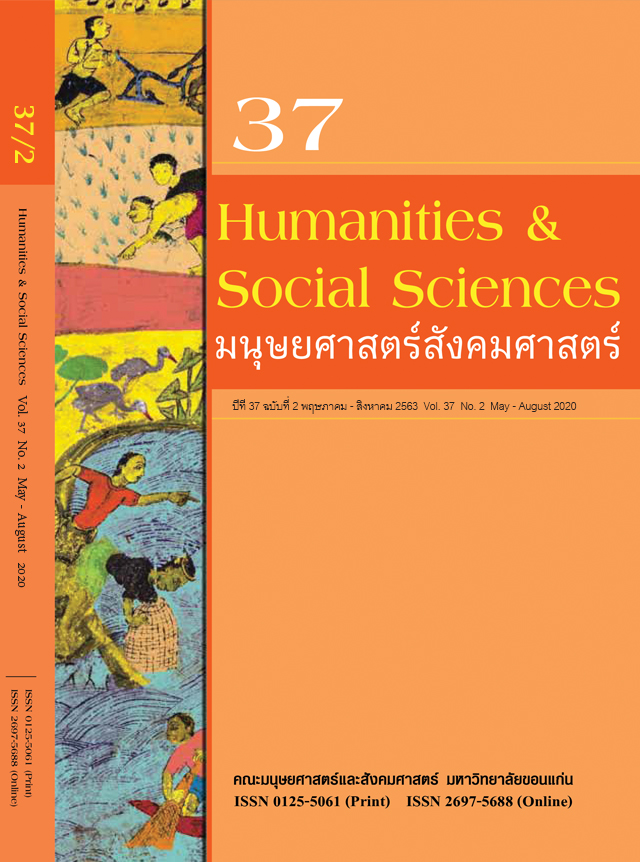อักษรธรรมล้านนาที่ประดิษฐ์ขึ้นเพิ่มเติมเพื่อใช้เขียนภาษาสันสกฤต
The Inventive Dhamma Lanna Script for Writing in Sanskrit
Keywords:
KEY WORDS; THE DHAMMA LANNA SCRIPT, SANSAKRIT, PALAEOGRAPHY, ORTHOGRAPHYAbstract
This research article aimed to study in 4 aspects: 1) To study the number and format of Dhamma Lanna script created by Lanna scholars for writing in Sanskrit, 2) To study the orthography of the Dhamma Lanna script for writing in Sanskrit, 3) To study the origin of Sanskrit language usage in the Lanna Kingdom, and 4) To study the creation concept of Dhamma Lanna script for writing in Sanskrit.
The results showed that, Lanna scholars have created an additional 9 letters for writing in Sanskrit in addition to the existing Dhamma Lanna script, consisted of 4 consonants: <ś> (palatal fricative), <ṣ> (retroflex fricative), Ro Repha, and Rohan; 3 vowels: <ṛ> (rue), <ai>, and <au>; 2 diacritics: Visarga and Virama. The newly invented letters in addition to the existing consonants of Dhamma Lanna script are <ś>, <ṣ>, <ṛ> and Virama. The existing letters that have new functions are Ro Repha (written like Ra Ham), Rohan (written like 2 <r> consonant alphabets), <ai> (written like <ae>), <au> (written like a combination of <e> and <ā>), and Visarga (written like <a>).
For the orthography of the Dhamma Lanna script for writing in Sanskrit, it is found that the letters that can act as initial consonants include <ś> and <ṣ> positioned at the beginning of the word or syllable. The 4 letters that can act as final consonants include <ś>, <ṣ>, Ro Repha, and Rohan, with the <ṣ> and <ṣ> subjoined consonants positioned under the consonant or the vowel, Ro Repha positioned above the consonant, and Rohan positioned behind the initial consonant of the spelled word.
For the orthography of the vowel, it is found that the vowel <ṛ> can be both independent and dependent. When acting as an independent vowel, it always appears at the beginning of a word or syllable. When acting as a dependent vowel, it is positioned after the initial consonant of the spelled word. <ai> will always appear in front of the consonant, while the mixed vowel <au> appears before and after the initial consonant of the spelled word. For the orthography of the diacritics, it is found that the Visarga will always appear at the end of the word, while the Virama appears above the final consonant of the spelled word.
For the origin of Sanskrit language usage in the Lanna Kingdom, there are evidences that Lanna monks have derived the script from Brahman scriptures used in Bagan City around BE 19th-21st century. The script was translated into Lanna language and some letters and orthography were invented to suit for writing in Sanskrit. As for the creation of Lanna script for writing in Sanskrit, the origin is not clear whether it was influenced from one of these scripts: Devanagari script, Burmese script, or Khom-Thai script. It is found that the letters in Dhamma Lanna script created for writing in Sanskrit are a mix of the same and different letters from the mentioned scripts. It is possible that the Lanna scholars have obtained the idea of script creation from many sets of letters. Moreover, it is found that some orthographical rules in Sanskrit writing have also influenced Lanna writing.
Keywords: The Dhamma Lanna Script, Sansakrit, Palaeography, Orthography
References
กรมศิลปากร. (2551). จารึกล้านนาภาค 2 เล่ม 1-2 : จารึกจังหวัดเชียงใหม่ ลำปาง ลำพูน และแม่ฮ่องสอน. กรุงเทพฯ:อมรินทร์พริ้นติ้งแอนด์พับลิชชิ่ง.
กรรณิการ์ วิมลเกษม. (2554). ตำราเรียนอักษรไทยโบราณ อักษรขอมไทย อักษรธรรมล้านนา อักษรธรรมอีสาน. กรุงเทพฯ: ภาควิชาภาษาตะวันออก คณะโบราณคดี มหาวิทยาลัยศิลปากร.
กรรณิการ์ วิมลเกษม. (2558). จารึกฐานปราสาทโลหะวัดวิชุน เมืองหลวงพระบาง. วารสารราชบัณฑิตยสภา, 40(2), 45-60.
กลุ่มหนังสือตัวเขียนและจารึก. (2558). สุปรีติธรรมราชชาดกคำหลวง. กรุงเทพฯ: สำนักหอสมุดแห่งชาติ กรมศิลปากร.
ก่องแก้ว วีระประจักษ์และนิยะดา ทาสุคนธ์. (2524). รายงานการวิจัยเรื่องการวิวัฒน์ของรูปอักษรธรรมล้านนา. กรุงเทพฯ: กองหอสมุดแห่งชาติ กรมศิลปากร.
ธัมม์ล้านนา. (2561, 15 กรกฎาคม). “พิสสนูกัมม์/พิสสนูกัรม์” [status update]. Facebook. https://www.facebook.com/Lannaliterature/photos/a.288701624961157/422244051606913/?type=3&theater
นพชัย แดงดีเลิศ. (2542). จารึกทวารวดี: การศึกษาเชิงอักขรวิทยา. วิทยานิพนธ์ศิลปศาสตรมหาบัณฑิต สาขาจารึกภาษาไทย มหาวิทยาลัยศิลปากร.
นัยนา โปร่งธุระ. (2525). อักษรธรรมล้านนา. วิทยานิพนธ์ศิลปศาสตรมหาบัณฑิต สาขาจารึกภาษาไทย มหาวิทยาลัยศิลปากร.
ประเสริฐ ณ นครและคณะ. (2534). จารึกล้านนาภาค 1 เล่ม 1 จารึกจังหวัดเชียงราย น่าน พะเยา แพร่. กรุงเทพฯ: มูลนิธิเจมส์ เอช ดับเบิ้ลยู ทอมป์สัน.
ประเสริฐ ณ นครและปวงคำ ตุ้ยเขียว. (2537). ตำนานมูลศาสนา เชียงใหม่ เชียงตุง. กรุงเทพฯ: ศักดิ์โสภาการพิมพ์.
ระวี จันทร์ส่อง. (2561). ธาตุมัญชรี : ว่าด้วยเรื่องธาตุในภาษาสันสกฤต. เชียงใหม่: ศูนย์บริการงานวิจัย มหาวิทยาลัยเชียงใหม่.
ราชบัณฑิตยสถาน. (2556). พจนานุกรมฉบับราชบัณฑิตยสถาน พ.ศ. 2554. กรุงเทพฯ: ราชบัณฑิตยสถาน.
วินัย พงศ์ศรีเพียร, บรรณาธิการ. (2535). ประชุมศิลาจารึก ภาคที่ 7 ประมวลจารึกที่พบในประเทศไทยและต่างประเทศ. กรุงเทพฯ: ม.ป.พ.
สำเนียง เลื่อมใส. (2547). มหากาพย์พุทธจริต ฉบับสมบูรณ์ : พุทธประวัติฝ่ายมหายานจากกวีนิพนธ์สันสกฤต. กรุงเทพฯ: ศูนย์สันสกฤตศึกษา มหาวิทยาลัยศิลปากร.
สุรสิทธิ์ ไทยรัตน์. (2559). วยาการศตกัม สุภาษิตร้อยกรองของ วยาส. กรุงเทพฯ: ภาควิชาภาษาไทย คณะมนุษยศาสตร์ มหาวิทยาลัยเกษตรศาสตร์.
อุดม รุ่งเรืองศรี รวบรวม. (2547). พจนานุกรมล้านนา – ไทย ฉบับแม่ฟ้าหลวง. เชียงใหม่: มิ่งเมือง.
Galloway, Charlotte. (2006). Burmese Buddhist Imagery of the Early Bagan Period (1044 – 1113). Doctor of Philosophy, Australian National University.
SanskritBible.in. (2563). Welcome to The Holy Bible in Sanskrit language. สืบค้นวันที่ 20 เมษายน 2563,. จาก http://www.sanskritbible.in/
ต้นฉบับตัวเขียน
จารึกวัดช้างค้ำ (นน.3). (พ.ศ.2091). ศิลาจารึก. 2 ด้าน. เส้นจาร. อักษรธรรมล้านนา. ภาษาล้านนาและภาษาบาลี และภาษาสันสกฤต. พิพิธภัณฑสถานแห่งชาติ น่าน อ.เมืองน่าน จ.น่าน.
มหาญาณมังคละ. (พ.ศ.2121). อธิกมาสวินิจฉัย อธิทินวินิจฉัย วัสสูปนายิกาวินิจฉัย. หนังสือใบลาน 1 ผูก. 94 หน้าลาน. เส้นจาร. อักษรธรรมล้านนา. ภาษาล้านนาและภาษาสันสกฤต. วัดนันทาราม อ.เมืองเชียงใหม่ จ.เชียงใหม่.
สิทธิญาณโกวิโท, ผู้คัดลอก. (พ.ศ.2316). มหาชาติเวสสันดรชาดก ฉบับมหาป่าเจ้าสรีจอมจันทร์เชียงแสน กัณฑ์
หิมพานต์. หนังสือใบลาน 1 ผูก. 62 หน้าลาน. เส้นจาร. อักษรธรรมล้านนา. ภาษาล้านนา ภาษาลี และภาษาสันสกฤต. วัดนาปัง อ.ภูเพียง จ.น่าน.
สิทธิญาณโกวิโท, ผู้คัดลอก. (พ.ศ.2316). มหาชาติเวสสันดรชาดก ฉบับมหาป่าเจ้าสรีจอมจันทร์เชียงแสน ทานกัณฑ์. หนังสือใบลาน 1 ผูก. 54 หน้าลาน. เส้นจาร. อักษรธรรมล้านนา. ภาษาล้านนา ภาษาลี และภาษาสันสกฤต. วัดนาปัง อ.ภูเพียง จ.น่าน.
สิทธิญาณโกวิโท, ผู้คัดลอก. (พ.ศ.2316). มหาชาติเวสสันดรชาดก ฉบับมหาป่าเจ้าสรีจอมจันทร์เชียงแสน กัณฑ์
วนประเวสน์. หนังสือใบลาน 1 ผูก. 31 หน้าลาน. เส้นจาร. อักษรธรรมล้านนา. ภาษาล้านนา ภาษาลี และภาษาสันสกฤต. วัดนาปัง อ.ภูเพียง จ.น่าน.
สิทธิญาณโกวิโท, ผู้คัดลอก. (พ.ศ.2316). มหาชาติเวสสันดรชาดก ฉบับมหาป่าเจ้าสรีจอมจันทร์เชียงแสน กัณฑ์
ชูชก. หนังสือใบลาน 1 ผูก. 37 หน้าลาน. เส้นจาร. อักษรธรรมล้านนา. ภาษาล้านนา ภาษาลี และภาษาสันสกฤต. วัดนาปัง อ.ภูเพียง จ.น่าน.
สิทธิญาณโกวิโท, ผู้คัดลอก. (พ.ศ.2316). มหาชาติเวสสันดรชาดก ฉบับมหาป่าเจ้าสรีจอมจันทร์เชียงแสน กัณฑ์
จุลพน. หนังสือใบลาน 1 ผูก. 17 หน้าลาน. เส้นจาร. อักษรธรรมล้านนา. ภาษาล้านนา ภาษาลี และภาษาสันสกฤต. วัดนาปัง อ.ภูเพียง จ.น่าน.
สิทธิญาณโกวิโท, ผู้คัดลอก. (พ.ศ.2316). มหาชาติเวสสันดรชาดก ฉบับมหาป่าเจ้าสรีจอมจันทร์เชียงแสน กัณฑ์
มหาพน. หนังสือใบลาน 1 ผูก. 31 หน้าลาน. เส้นจาร. อักษรธรรมล้านนา. ภาษาล้านนา ภาษาลี และภาษาสันสกฤต. วัดนาปัง อ.ภูเพียง จ.น่าน.
สิทธิญาณโกวิโท, ผู้คัดลอก. (พ.ศ.2316). มหาชาติเวสสันดรชาดก ฉบับมหาป่าเจ้าสรีจอมจันทร์เชียงแสน กัณฑ์
มัทรี. หนังสือใบลาน 1 ผูก. 47 หน้าลาน. เส้นจาร. อักษรธรรมล้านนา. ภาษาล้านนา ภาษาลี และภาษาสันสกฤต. วัดนาปัง อ.ภูเพียง จ.น่าน.
สิทธิญาณโกวิโท, ผู้คัดลอก. (พ.ศ.2316). มหาชาติเวสสันดรชาดก ฉบับมหาป่าเจ้าสรีจอมจันทร์เชียงแสน กัณฑ์
สักบรรพ. หนังสือใบลาน 1 ผูก. 30 หน้าลาน. เส้นจาร. อักษรธรรมล้านนา. ภาษาล้านนา ภาษาลี และภาษาสันสกฤต. วัดนาปัง อ.ภูเพียง จ.น่าน.
หนังสือเส้นข้าว. (พ.ศ.2326). หนังสือใบลาน 1 ผูก. 7 หน้าลาน. เส้นจาร. อักษรธรรมล้านนา. ภาษาล้านนาและภาษาสันสกฤต. วัดม่วงตึ๊ด อ.ภูเพียง จ.น่าน.
ญาณมังคละ. (พ.ศ.2398). นิสสัยรามเหียร. หนังสือใบลาน 6 ผูก. 389 หน้าลาน. เส้นจาร. อักษรธรรมล้านนา. ภาษาล้านนาและภาษาสันสกฤต. วัดนาหวาย อ.นาหมื่น จ.น่าน.
นิไสธัมมจักกะปวัตตะนะสูตร์. (พ.ศ.2377). หนังสือใบลาน 7 ผูก. 204 หน้าลาน. เส้นจาร. อักษรธรรมล้านนา. ภาษาล้านนาและภาษาบาลี. วัดสูงเม่น อ.สูงเม่น จ.แพร่. สืบค้นวันที่ 20 เมษายน 2563. จาก, annamanuscripts.net/th/manuscripts/2468
โวหารธัมมจักก์ มัดสาม. (พ.ศ.2284). หนังสือใบลาน 13 ผูก. 345 หน้าลาน. เส้นจาร. อักษรธรรมล้านนา. ภาษาล้านนาและภาษาบาลี. วัดสูงเม่น อ.สูงเม่น จ.แพร่. สืบค้นวันที่ 20 เมษายน 2563. จาก, http://lannamanuscripts.net/th/manuscripts/945



